The Sensitivity of Characteristics of Large Scale Baroclinic Unstable Waves in Southern Hemisphere to the Underlying Climate
Abstract
The sensitivity of the main characteristics of baroclinically unstable waves with respect to fundamental parameters of the atmosphere (the static stability parameter σ0 and vertical shear of a zonal wind Λ) is theoretically explored. Two types of waves are considered: synoptic scale waves and planetary scale (ultralong) waves based on an Eady-type model and model with vertically averaged primitive equations. Sensitivity functions are obtained that estimate the impact of variations in σ0 and Λ on the growth rate and other characteristics of unstable waves and demonstrate that waves belonging to the short-wave part of the spectrum of unstable waves are more sensitive to changes in the static stability parameter than waves belonging to the long-wave part of the spectrum. The obtained theoretical results show that the increase of the static stability and decrease of the meridional temperature gradient in midlatitude baroclinic zones in some areas of the southern hemisphere lead to a slowing of the growth rate of baroclinic unstable waves and an increasing wavelength of baroclinic unstable wave maximum growth rate, that is, a spectrum shift of unstable waves towards longer wavelengths. These might affect the favorable conditions for the development of baroclinic instability and, therefore, the intensity of cyclone generation activity.
1. Introduction
Static stability and the meridional temperature gradient (MTG) are among the most important fundamental parameters characterizing the state of the atmosphere and, in particular, midlatitude large-scale eddy dynamics [1, 2]. Static stability and MTG play a significant role in the development of baroclinic instability which is the dominant mechanism for generating large-scale atmospheric eddies (cyclones) that form the storm tracks in midlatitudes. The physical nature of baroclinic instability is well understood and explained in the scientific literature, including text books on dynamic meteorology (e.g., [1–4]). Baroclinic instability can be viewed as sloping convection where growing perturbations draw upon the available potential energy which is proportional to a meridional temperature gradient. Since the publication of the pioneering theoretical works of Charney [5] and Eady [6], in which the fundamental baroclinic mechanism of the atmospheric large-scale instability was first described, many scientific papers have been published that examine the growth of initially infinitesimal perturbations in the atmosphere and ocean caused by baroclinic effects. Both linear theory for the onset of baroclinic instability and its nonlinear saturation have been explored in many research articles. A thorough review of baroclinic instability is presented in [7] and to some extent in [8, 9]. Theoretical models of baroclinic instability typically represent linearized dynamics equations and the instability problem is examined as an eigenvalue problem. The nonmodal instability analysis in both linear and nonlinear formulations is more general than eigenanalysis. This technique suggests the solution of a Cauchy (initial value) problem (e.g., [10–12]). Analytical weakly nonlinear theories of baroclinic instability represent a further extension of research (e.g., [13–16]) which focuses on the finite-amplitude behaviour of unstable baroclinic waves. Other areas of studies have explored the life-cycle behaviour of baroclinic unstable waves to understand how initially infinitesimal perturbations grow to large but finite amplitude modifying the mean flow. This kind of research requires numerical integration of the atmospheric nonlinear model equations (e.g., [17–20]).
It is important to underline the significant role of the two-layer model of Philips [21, 22] and its modifications (e.g., [13, 23–28]) in developing baroclinic instability theories. However, for this purpose a two-layer model was usually used in the quasigeostrophic approximation. A generalized baroclinic instability analysis based on two-level primitive-equation model has been described in [29] and applied to detailed consideration of the baroclinic instability mechanism.
There is evidence of an increase over the past decades of the static stability in the extratropics [30] and a pole-ward movement of the midlatitude precipitation zones and storm tracks which are uniquely linked to zones with strong MTG-baroclinic zones (e.g., [31–35]). Recent studies have also indicated an increase in intensity of extratropical cyclones and a decrease in frequency [36–44]. Changes in geographical locations and intensity of storm tracks are more distinct in the southern hemisphere (SH) (e.g., [45]) affecting the essential features of weather patterns over large territories such as Australia [46–54] and indicating a change of favourable conditions for baroclinic instability because the key role of baroclinic instability in the development of midlatitude cyclones is well established.
It should be pointed out that, since the beginning of the 1980s, exploration of the essential features of the atmospheric general circulation in the SH has been facilitated by the availability of plentiful satellite upper-air data. In particular, the importance of baroclinic instability and large-scale eddies in the formation of zonal wind characteristics, such as a tropospheric double-jet phenomenon, was studied in [56, 57].
Taking into account the significant role of baroclinic instability in the development of midlatitude cyclones and the intensity changes of baroclinic instability in some areas of the SH in recent decades, this paper examines the sensitivity of the main characteristics of baroclinically unstable waves (e.g., the growth rates of unstable waves as function of wavelength) to fundamental atmospheric parameters: the static stability parameter σ0 which is characterized by temperature lapse rate Γ = −∂T/∂z, and zonal wind vertical shear Λ which, by thermal wind balance, characterizes the meridional temperature gradient. Two classes of waves [55] are considered. The first one is characterized by the Rossby number Ro ≡ U/(fL) ~ 0.1 and the representative horizontal length scale L which is smaller than the Earth’s radius a0, that is, L/a0 ~ 0.1. Here U is a horizontal velocity scale and f is the Coriolis parameter. For this class of waves ζ ≫ D, where ζ is the vertical component of relative vorticity and D is the horizontal divergence. Synoptic scale waves belong to this type of motion [58]. The second class, which includes planetary, or ultralong, waves [59], is characterized by Ro ~ 0.01 and L/a0 ~ 1. For these waves the magnitude of horizontal divergence is comparable with the vertical component of vorticity; that is, ζ ≈ D. To study synoptic scale waves, the Eady-type model is used with uniform zonal wind shear between upper and lower boundaries on an f-plane. In this context parameters σ0 and Λ are considered to be variables that control the development of baroclinic instability in the atmosphere. Ultralong waves are investigated based on a model with vertically averaged equations [60, 61] with a β-plane approximation. Simplified models such as the Eady model of baroclinic instability and models with vertically averaged equations, despite their simplicity, allow solutions to be obtained that clearly illustrate real physical processes in the atmosphere.
2. Synoptic Scale Baroclinically Unstable Waves
2.1. The Model Equations
As we can see from (16), at a given latitude the growth rate χk is a function of σ0 (static stability), Λξ (wind shear), and quantity η that depends on the horizontal wavenumber k and σ0.
2.2. Impact of Static Stability and Vertical Wind Shear on Baroclinic Instability
Within the Eady problem framework, the static stability parameter σ0 and the vertical wind shear Λξ represent the main control variables. By varying σ0 and Λξ, one can obtain estimates of the impact of these parameters on the development of baroclinic instability in the atmosphere. In this research, parameters corresponding to the basic state are given the following values: Λξ = 40 ms−1 [50] and σ0 = 2 × 10−6 m2 Pa−2 s−2 [1]. These parameter values can be used as an approximation to describe the zonal-averaged atmospheric conditions for JJA (June, July, and August) in the SH [50]. The latitude of interest is assumed to be φ0 = 45 S which gives f0 = −1.028 × 10−4 s−1.
Figure 1 shows plot of Eady growth rate versus zonal wavenumber obtained with (16). The growth rate has a short-wave instability cutoff beyond which waves are stable. Let Lmin be the wavelength that corresponds to a short-wave cutoff. Value of Lmin can be obtained from (14) when η = ηc which gives Lmin = 3592 km. To calculate the wavelength of maximum growth rate Lχmax , one can take ∂χk/∂k and set the result equal to zero which gives η = ηm ≈ 1.6061. Then by using (14) we can obtain Lχmax = 5366 km.
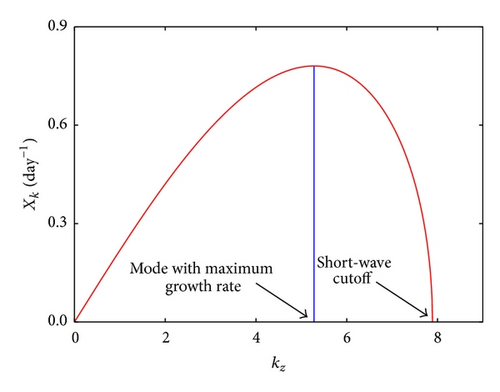
The influence of the static stability parameter on the wavelength of maximum growth rate Lχmax and the short wave cut-off Lmin are shown in Figure 2. In general, an increase in the parameter σ0 leads to an increase in both Lkcmax and Lmin . The functional dependences between Lmin and σ0, and between Lkcmax and σ0 are almost linear: ±10% departure of static stability parameter Δσ0 from its nominal value σ0 = 2.0 × 10−6 m2 Pa−2 s−2 results in about ±5% change for both Lkcmax and Lmin with respect to the nominal value σ0. For instance, if Δσ = 0.1 × σ0, then Lkcmax = 5628 and Lmin = 3768 km, and if Δσ = −0.1σ0, then Lkcmax = 5091 and Lmin = 3408 km.
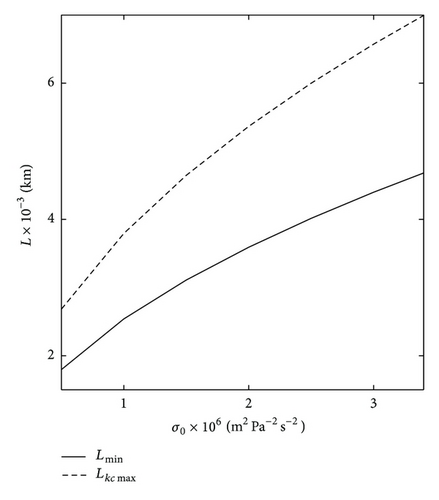
Figure 3 illustrates the growth rate of unstable waves versus the static stability parameter at different values of Λξ. Parameters σ0 and Λξ influence the growth rate χk in the opposite direction: growth rate decreases if σ0 increases and if Λξ decreases. Note that the decrease of the parameter Λξ indicates the weakening of the intensity of the baroclinic zone, that is, reduction of the MTG. In nature both of these processes take place, which leads to a synergistic effect. For instance, if Λξ decreases by 10% and the static stability parameter increases by 10%, the growth rate χk decreases by 14%.
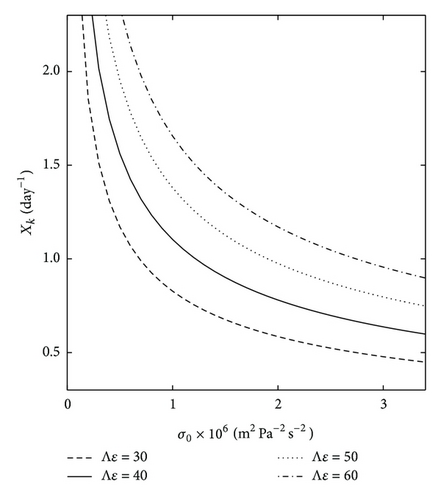
| σ0 m2 Pa−2 s−2 | Zonal wave number kz | ||||||
|---|---|---|---|---|---|---|---|
| 1 | 2 | 3 | 4 | 5 | 6 | 7 | |
| 1.0 × 10−6 | −0.0157 | −0.1251 | −0.4175 | −0.9772 | −1.8879 | −3.2470 | −5.2005 |
| 1.5 × 10−6 | −0.0157 | −0.1245 | −0.4139 | −0.9675 | −1.8794 | −3.3014 | −5.5927 |
| 2.0 × 10−6 | −0.0157 | −0.1240 | −0.4110 | −0.9626 | −1.8979 | −3.4964 | −6.9371 |
| 2.5 × 10−6 | −0.0157 | −0.1234 | −0.4088 | −0.9629 | −1.9509 | −3.9665 | −23.0031 |
| 3.0 × 10−6 | −0.0157 | −0.1230 | −0.4071 | −0.9691 | −2.0540 | −5.3057 | |
| σ0 m2 Pa−2 s−2 | Zonal wave number kz | ||||||
|---|---|---|---|---|---|---|---|
| 1 | 2 | 3 | 4 | 5 | 6 | 7 | |
| 1.0 × 10−6 | −0.0062 | −0.0250 | −0.0575 | −0.1057 | −0.1735 | −0.2692 | −0.4095 |
| 1.5 × 10−6 | −0.0093 | −0.0379 | −0.0881 | −0.1656 | −0.2837 | −0.4749 | −0.8371 |
| 2.0 × 10−6 | −0.0124 | −0.0509 | −0.1201 | −0.2375 | −0.4220 | −0.8004 | −1.9939 |
| 2.5 × 10−6 | −0.0156 | −0.0642 | −0.1539 | −0.3087 | −0.6071 | −1.4399 | −31.4243 |
| 3.0 × 10−6 | −0.0187 | −0.0777 | −0.1898 | −0.3974 | −0.8759 | −3.4322 | |
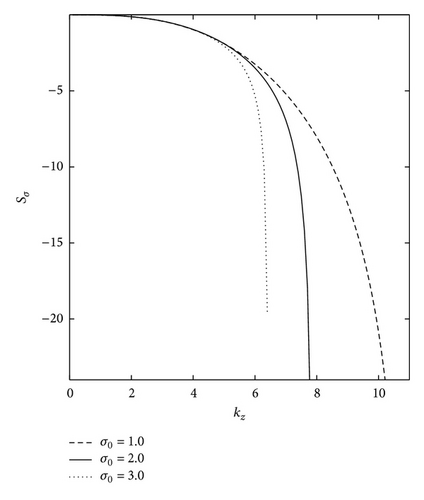

The obtained results are consistent with observations [50, 51, 54]: an increase in static stability and a decrease of the MTG have occurred over the past few decades in some areas of the SH, which has led to a decrease in the growth rate of baroclinic unstable waves, a shift of the spectrum of unstable waves in the long wavelength part of spectrum, and a weakened intensity of cyclogenesis. Naturally, these changes affect favourable conditions for the development of baroclinic instability and the essential features of weather patterns over large territories, particularly over Australia.
3. Planetary Scale Waves
- (a)
acoustic waves
(24) - (b)
Rossby wave
(25) - (c)
baroclinic wave
(26)
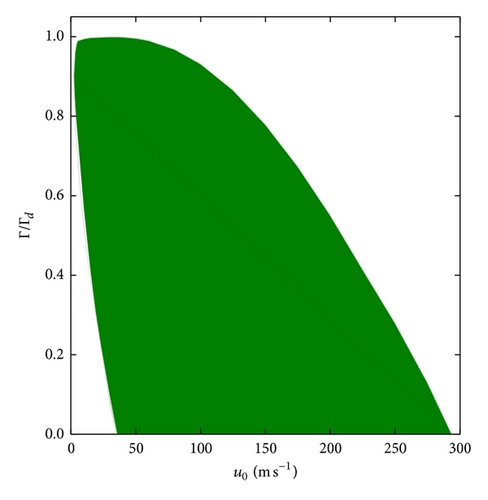
The imaginary part of phase velocity ci which characterises the growth rate of unstable waves χk ≡ kci is displayed in Figure 7 as a function of dimensionless temperature lapse rate Γ/Γd for different values of vertically averaged zonal wind velocity u0. A maximum phase velocity ci exists for given values of u0; that is, dependent on the ratio of Γ/Γd. For instance, if u0 = 20 m s−1 then the maximum value (ci) max ≈ 8.34 m s−1 is reached at Γ/Γd ≈ 0.55. Figure 6 shows that increasing vertically averaged zonal wind u0 is associated with increasing ci. This is further evident in Figure 8, which shows ci as a function of u0 for a range of Γ/Γd values. The lower Γ/Γd and the larger ci, that is, ci, increases with decreasing static stability.
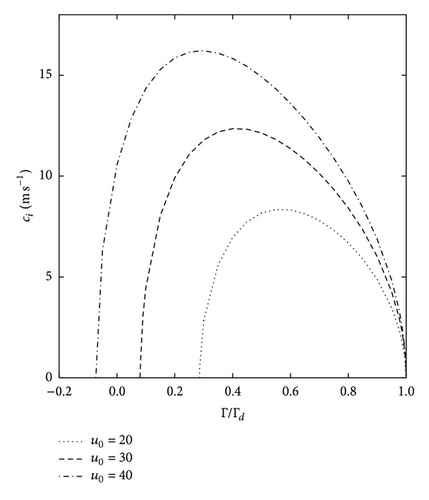
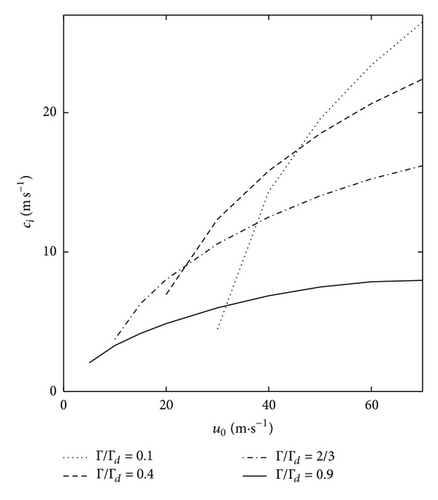
4. Concluding Remarks
We have studied theoretically the impact of variations in the static stability parameter σ0 and zonal wind shear Λξ on the characteristics of baroclinically unstable waves of synoptic scales using Eady-type model with the uniform Λξ between upper and lower boundaries on an f-plane. Quantitative estimates of variations in σ0 and Λξ on the growth rate χk, wavelength of maximum growth rate Lχmax , and short-wave cutoff Lmin were obtained.
Analytical expressions are derived for sensitivity functions for the growth rate χk with respect to variations in static stability parameter and wind shear velocity. These expressions allow estimating to a first-order approximation the influence of changes in σ0 and Λξ on χk. Analytical expressions for relative sensitivity functions allow estimating the significance of variations in σ0 and Λξ on the growth rate of baroclinically unstable waves with a given zonal wave number.
To study the impact of variations in atmospheric static stability and zonal wind velocity on the instability of planetary scale waves, the model with vertically averaged primitive equations with β-plane approximation was applied. As control parameters, we have used dimensionless temperature lapse rate Γ/Γd and vertically averaged zonal wind velocity u0. We have estimated the influence of Γ/Γd and u0 on the imaginary part of phase speed ci, which was used as a measure of instability.
The obtained results are qualitatively consistent with changes in the essential weather patterns that occurred over the last several decades in some areas of the SH and, in particular, over Australia (e.g., [49, 50, 52–54]). Climate change results suggest SH midlatitude static stability σ0 may increase and the MTG (the vertical wind shear Λξ) may decrease, which according to our linear theoretical models leads to a slowing of the growth rate of baroclinic unstable waves χk and an increasing wavelength of baroclinic unstable wave with maximum growth rate Lχmax , that is, a spectrum shift of unstable waves towards longer wavelengths. These might affect the favourable conditions for the development of baroclinic instability and, therefore, the rate of cyclogenesis and a reduction in cyclone intensity. The obtained sensitivity functions demonstrate that waves belonging to the short-wave part of the spectrum of unstable waves are more sensitive to changes in the static stability parameter than waves belonging to the long-wave part of the spectrum.
To obtain more realistic estimates of the sensitivity of the growth rate of unstable waves with respect to static stability parameter and MTG, numerical modeling based on a full GCM is required. It is hoped to carry out such work in the future.
Conflict of Interests
The authors declare that there is no conflict of interests regarding the publication of this paper.
Acknowledgment
The authors thank Dr. I. Pisnichenko for clarification of certain questions relevant to this paper.




